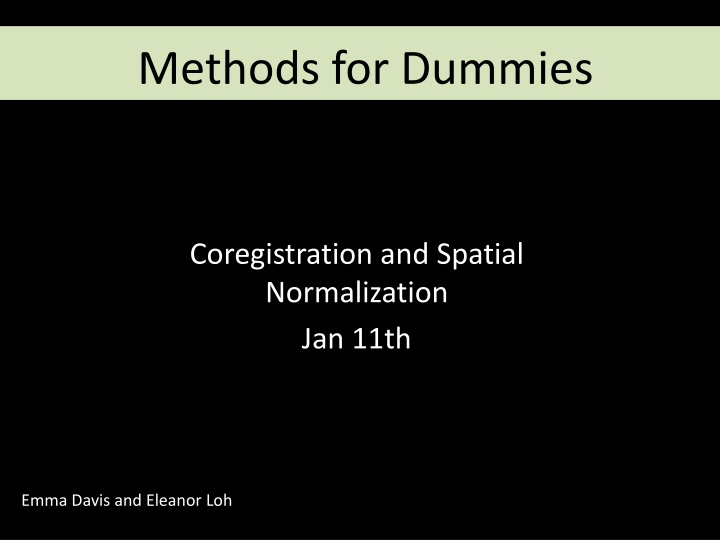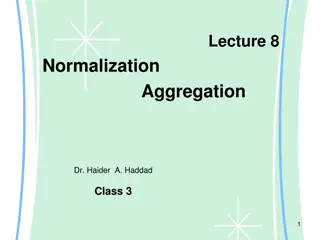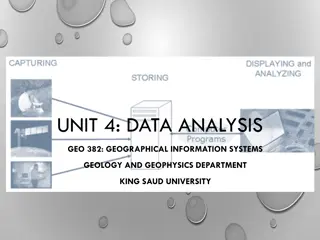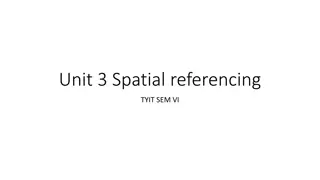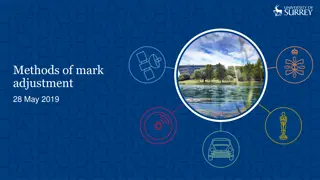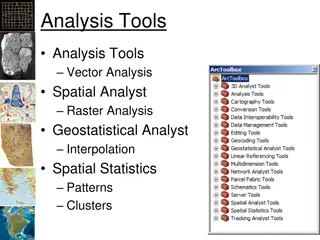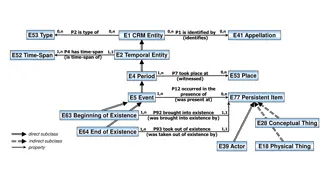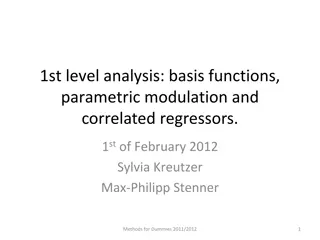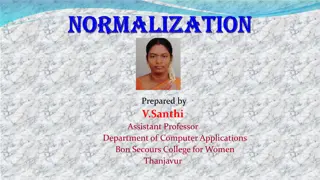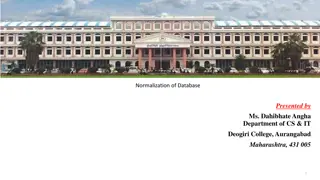fMRI Coregistration and Spatial Normalization Methods
fMRI data analysis involves coregistration and spatial normalization to align functional and structural images, reduce variability, and prepare data for statistical analysis. Coregistration aligns images from different modalities within subjects, while spatial normalization achieves precise anatomical localization. Preprocessing steps include removing variability and improving signal-to-noise ratio. The process involves realigning, reslicing, and interpolating data points to enhance accuracy.
Download Presentation

Please find below an Image/Link to download the presentation.
The content on the website is provided AS IS for your information and personal use only. It may not be sold, licensed, or shared on other websites without obtaining consent from the author.If you encounter any issues during the download, it is possible that the publisher has removed the file from their server.
You are allowed to download the files provided on this website for personal or commercial use, subject to the condition that they are used lawfully. All files are the property of their respective owners.
The content on the website is provided AS IS for your information and personal use only. It may not be sold, licensed, or shared on other websites without obtaining consent from the author.
E N D
Presentation Transcript
Methods for Dummies Coregistration and Spatial Normalization Jan 11th Emma Davis and Eleanor Loh
fMRI fMRI data as 3D matrix of voxels repeatedly sampled over time. fMRI data analysis assumptions Each voxel represents a unique and unchanging location in the brain All voxels at a given time-point are acquired simultaneously. These assumptions are always incorrect, moving by 5mm can mean each voxel is derived from more than one brain location. Also each slice takes a certain fraction of the repetition time or interscan interval (TR) to complete. Issues: - Spatial and temporal inaccuracy - Physiological oscillations (heart beat and respiration) - Subject head motion
Preprocessing Computational procedures applied to fMRI data before statistical analysis to reduce variability in the data not associated with the experimental task. Regardless of experimental design (block or event) you must do preprocessing 1. Remove uninteresting variability from the data Improve the functional signal to-noise ratio by reducing the total variance in the data 2. Prepare the data for statistical analysis
Overview Func. time series Coreg + Spatial Normalization Smooth Realign Unwarp Motion corrected
Coregistration How does activity map onto anatomy? How consistent is this across subjects? Coregistration Aligns two images from different modalities (i.e. Functional to structural image) from the same individual (within subjects). Functional Images have low resolution Similar to realignment but different modalities. Structural Images have high resolution (can distinguish tissue types) Allows anatomical localisation of single subject activations; can relate changes in BOLD signal due to experimental manipulation to anatomical structures. Achieve a more precise spatial normalisation of the functional image using the anatomical image.
Coregistration Steps 1. Registration determine the 6 parameters of the rigid body transformation between each source image (i.e. fmri) and a reference image (i.e. Structural) (How much each image needs to move to fit the source image) Rigid body transformation assumes the size and shape of the 2 objects are identical and one can be superimposed onto the other via 3 translations and 3 rotations Z X Y
Realigning 2. Transformation the actual movement as determined by registration (i.e. Rigid body transformation) 3. Reslicing - the process of writing the altered image according to the transformation ( re-sampling ). 4. Interpolation way of constructing new data points from a set of known data points (i.e. Voxels). Reslicing uses interpolation to find the intensity of the equivalent voxels in the current transformed data. Changes the position without changing the value of the voxels and give correspondence between voxels.
Coregistration Different methods of Interpolation 1. Nearest neighbour (NN) (taking the value of the NN) 2. Linear interpolation all immediate neighbours (2 in 1D, 4 in 2D, 8 in 3D) higher degrees provide better interpolation but are slower. 3. B-spline interpolation improves accuracy, has higher spatial frequency (NB: NN and Linear are the same as B-spline with degrees 0 and 1) NB: the method you use depends on the type of data and your research question, however the default in SPM is 4th order B-spline
Coregistration As the 2 images are of different modalities, a least squared approach cannot be performed. To check the fit of the coregistration we look at how one signal intensity predicts another. The sharpness of the Joint Histogram correlates with image alignment.
Coregistration Coregister: Estimate; Ref image use dependency to select Realign & unwarp: unwarped mean image Source image use the subjects structural Coregistration can be done as Coregistration:Estimate; Coregistration: Reslice; Coregistration Estimate & Reslice. NB: If you are normalising the data you don t need to reslice as this writing will be done later
Check Registration Check Reg Select the images you coregistered (fmri and structural) NB: Select mean unwarped functional (meanufMA...) and the structural (sMA...) Can also check spatial normalization (normalised files wsMT structural, wuf functional)
Overview Statistical Parametric Map Design matrix fMRI time-series kernel Motion correction Smoothing General Linear Model (Co-registration and) Spatial normalisation Parameter Estimates Standard template
Preprocessing Steps Realignment (& unwarping) Motion correction: Adjust for movement between slices Coregistration Overlay structural and functional images: Link functional scans to anatomical scan Normalisation Warp images to fit to a standard template brain Smoothing To increase signal-to-noise ratio Extras (optional) Slice timing correction; unwarping
Within Person vs. Between People Co-registration: Within Subjects PET T1 MRI Spatial Normalisation: Between Subjects Problem: Brain morphology varies significantly and fundamentally, from person to person (major landmarks, cortical folding patterns)
What is Normalisation? Solution: Match all images to a template brain. A kind of co-registration, but one where images fundamentally differ in shape Template fitting: stretching/squeezing/warping images, so that they match a standardized anatomical template Establishes a voxel-to-voxel correspondence, between brains of different individuals
Why Normalise? Matching patterns of functional activation to a standardized anatomical template allows us to: Average the signal across participants Derive group statistics Improve the sensitivity/statistical power of the analysis Generalise findings to the population level Group analysis: Identify commonalities/differences between groups (e.g. patient vs. healthy) Report results in standard co-ordinate system (e.g. MNI) facilitates cross-study comparison
Standard spaces (What are we normalizing our data to) The Talairach Atlas The MNI/ICBM AVG152 Template Talairach: Not representative of population (single-subject atlas) Slices, rather than a 3D volume (from post-mortem slices) MNI: Based on data from many individuals (probabilistic space) Fully 3D, data at every voxel SPM reports MNI coordinates (can be converted to Talairach) Shared conventions: AC is roughly [0 0 0], xyz axes = right-left, anterior-posterior, superior-inferior
Spatial normalization as a process of optimization In a functional study, we want to match functionally homologous regions between different subjects (i.e. we want to make our functional (& structural) images look like the template) 1) Structure-function relationship varies from subject to subject Co-registration algorithms differ (due to fundamental structural differences) fundamentally, standardization/full alignment of functional data is not perfect 2) Normalization involves a flexible warp Flexible warp = thousands of parameters to play around with Even if it were possible to match all our images perfectly to the template, we might not be able to find this solution The challenge of spatial normalization is optimization Optimization/compromise approach in SPM: Correct for large scale variability (e.g. size of structures) (Smoothing) smooth over small-scale differences (compensate for residual misalignments)
Types of Spatial Normalisation Label based (anatomy based) Identify homologous features (points, lines) in the image and template Find the transformations that best superimpose them Limitation: Few identifiable features, manual feature-identification (time consuming and subjective) 1. 2. Non-label based (intensity based) Identifies a spatial transformation that optimizes voxel similarity, between template and image measure Optimization = Minimize the sum of squares, which measures the difference between template and source image Limitation: susceptible to poor starting estimates (parameters chosen) Typically not a problem priors used in SPM are based on parameters that have emerged in the literature Special populations SPM uses the intensity-based approach Adopts a two-stage procedure: 12-parameter affine (linear transformation) Warping (Non-linear transformation)
Step 1: Affine Transformation Determines the optimum 12- parameter affine transformation to match the size and position of the images 12 parameters = 3df translation 3 df rotation 3 df scaling/zooming 3 df for shearing or skewing Fits the overall position, size and shape Rotation Shear Translation Zoom
Step 2: Non-linear Registration (warping) Warp images, by constructing a deformation map (a linear combination of low- frequency periodic basis functions) For every voxel, we model what the components of displacement are Gets rid of small-scale anatomical differences
Results from Spatial Normalisation Affine registration Non-linear registration
Risk: Over-fitting Affine registration. ( 2 = 472.1) Template image Non-linear registration without regularisation. ( 2 = 287.3) Over-fitting: Introduce unrealistic deformations, in the service of normalization
Risk: Over-fitting Affine registration. ( 2 = 472.1) Template image Non-linear registration without regularisation. ( 2 = 287.3) Non-linear registration using regularisation. ( 2 = 302.7)
Apply Regularisation (protect against the risk of over-fitting) Regularisation terms/constraints are included in normalization Ensures voxels stay close to their neighbours Involves Setting limits to the parameters used in the flexible warp (affine transformation + weights for basis functions) Manually check your data for deformations e.g. Look through mean functional images for each subject - if data from 2 subjects look markedly different from all the others, you may have a problem
Unified Segmentation (So far) We ve matched to a template that contains information only about voxel image intensity Unified segmentation: Matched to (probabilistic) model of different tissue classes (white, grey, CSF) Theoretically similar issues (e.g. overfitting, optimization), but template has much more information The SPM-recommended approach!
SPM: (1) Spatial normalization Data for a single subject Double-click Data to add more subjects (batch) Source image = Structural image Images to Write = co- registered functionals Source weighting image = (a priori) create a mask to exclude parts of your image from the estimation+writing computations (e.g. if you have a lesion) See presentation comments, for more info about other options
SPM: (1) Spatial normalization Template Image = Standardized templates are available (T1 for structurals, T2 for functional) Bounding box = NaN(2,3) Instead of pre-specifying a bounding box, SPM will get it from the data itself Voxel sizes = If you want to normalize only structurals, set this to [1 1 1] smaller voxels Wrapping = Use this if your brain image shows wrap-around (e.g. if the top of brain is displayed on the bottom of your image) w for warped
SPM: (2) Unified Segmentation Batch SPM Spatial Segment SPM Spatial Normalize Write
SPM: (2) Unified Segmentation Data = Structural file (batched, for all subjects) Tissue probability maps = 3 files: white matter, grey matter, CSF (Default) Masking image = exclude regions from spatial normalization (e.g. lesion) Parameter File = Click Dependency (bottom right of same window) Images to Write = Co- registered functionals (same as in previous slide)
References for spatial normalization SPM course videos & slides: http://www.ucl.ac.uk/stream/media/swatch?v=1d42446d1c34 Previous MfD Slides Rik Henson s Preprocessing Slides: http://imaging.mrc- cbu.cam.ac.uk/imaging/ProcessingStream
Smoothing Why? 1. Improves the Signal-to-noise ratio therefore increases sensitivity 2. Allows for better spatial overlap by blurring minor anatomical differences between subjects 3. Allow for statistical analysis on your data. Fmri data is not parametric (i.e. normal distribution) How much you smooth depends on the voxel size and what you are interested in finding. i.e. 4mm smoothing for specific anatomical region.
Smoothing Smooth; Images to smooth dependency Normalise:Write:Normalised Images 4 4 4 or 8 8 8 (2 spaces) also change the prefix to s4/s8
Preprocessing - Batches To make life easier once you have decided on the preprocessing steps make a generic batch Leave X blank, fill in the dependencies. Fill in the subject specific details (X) and SAVE before running. Load multiple batches and leave to run. When the arrow is green you can run the batch.
